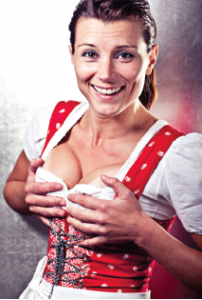Can you add more saline to my implants so I don’t have to have surgery again?
By Dr. Ted
Technically, I could open your incision and add some saline to your breast implants, but it doesn’t make sense. Here’s why: Breast implants come in various sizes, like 325 ccs or 450 ccs, and they can’t be expanded an infinite amount. If implants are over-expanded, they will feel hard, like balloons that have been blown up too much. There might be room for a little bit more saline solution (salt water) – maybe two tablespoons at most – the amount of oil you would add to your pancake mix. This small amount would be barely noticeable. In fact, you could get the same look by wearing your bra one notch tighter.

In 1937, Warner’s introduced its “Alphabet Bra” with A, B, C and D cups. Before too long,
these cup sizes got nicknames: egg cup, tea cup, coffee cup and challenge cup.
Women come to me with the request to “go bigger” often after significant weight loss (about 10 percent or more of their body weight) or after pregnancy, when their breasts may have changed because of hormonal fluctuations and milk production.
In my experience, women want an increase of about one cup size or more, which would be equivalent to anywhere from 150 to 225 ccs, depending on the size of their frame. To accomplish this, they would need larger implants.
By the way, bigger implants aren’t more expensive than smaller ones. Manufacturers don’t charge by the cubic centimeter: They charge one set price for all off-the-shelf saline breast implants, whether they are 200 ccs or 600 ccs, and another set price (about $1,000 higher) for silicone gel implants.
Breast augmentation is easier the second time around, because the pocket around the implant has already been made and has already healed. During surgery, I would place a larger implant through the initial incision, which was made in the crease below the breast where the breast and the chest meet.
Post-operatively, to protect the incision, I ask patients to wear a supportive bra or a sports bra for three weeks. They report significantly less discomfort than the first time around, and women who have surgery on Friday are usually back to work on Monday if they work in an office setting.
The saline implants used during breast augmentation surgery are different from the temporary tissue expanders used during breast reconstruction surgery. These have a tube that runs from the expander to the skin near the outside of the body. Saline can be added over a period of months to gradually stretch the muscle and skin. The expander is then removed and replaced with a permanent implant.
P.S. While saline implants come empty and are filled after they are inserted, silicone gel implants come filled. There’s no way to add silicone to them.


